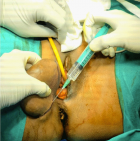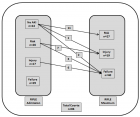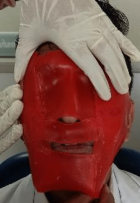About Indiana University School of Medicine
Indiana University School of Medicine
Articles by Indiana University School of Medicine
Low sensitivity of the careHPV™ Assay for detection of Oncogenic Human Papillomavirus in cervical samples from HIV-infected and HIV-uninfected Kenyan women
Published on: 30th January, 2020
OCLC Number/Unique Identifier: 8535181241
Background: Human papillomavirus (HPV) infection causes cervical cancer (CC), a common malignancy among Kenyan women. New CC screening methods rely on oncogenic HPV (“high-risk”, or HR-HPV) detection, but most have not been evaluated in swabs from Kenyan women.
Methods: HPV typing was performed on 155 cervical swabs from Kenyan women using the Roche Linear Array® (LA) and careHPV™ (careHPV) assays. Detection of 14 oncogenic HPV types in careHPV assay was compared to LA results.
Results: Compared to LA, sensitivity and specificity of careHPV assay was 53.0% and 80.9%, respectively. The sensitivity and specificity of careHPV in swabs from women with cervical dysplasia was 74.1% and 65.2%, respectively. The sensitivity and specificity of careHPV in swabs from HIV-infected women was 55.9% and of 96.4%, respectively. Overall agreements of careHPV assay with LA was substantial.
Conclusion: The results for careHPV assay are promising for oncogenic HPV detection in Kenyan women. The low sensitivity of careHPV for detection of HR-HPV could limit it’s benefit as a screening tool. Thus, a full clinical validation study is highly desirable before the careHPV assay can be accepted for cervical cancer screening.
Case-based education to improve learning and faculty teaching of residents and students in a clinical setting
Published on: 5th February, 2020
OCLC Number/Unique Identifier: 8553243394
Introduction: Current pediatric residents spend less time in the neonatal intensive care unit (NICU) and as a result, resident exposure to neonatal pathophysiology has decreased. Engaging learners efficiently while balancing clinical demands is challenging. Practices to enhance adult education include integration of problem centered learning into the demands of daily life in an environment in which learners feel safe asking questions and expressing themselves.
Methods: With this principal in mind, we developed a curriculum to enhance resident and medical student education during busy NICU rotations. The curriculum was case-based, available on-line and facilitated by neonatology faculty and fellows. A template designed to be concise and interactive was used to create and present the cases. After the case vignette, the template prompted medical students and residents to generate a differential diagnosis, order a diagnostic workup and narrow the diagnosis. Discussion of the diagnoses occurred at the conclusion of the cases; however, the template discouraged didactic lectures.
Results: In two years, cases were viewed 2,362 times. Facilitators and learners rated the quality and utility of the cases favorably overall. Cases took approximately 20 minutes to complete. Approximately 57% of survey respondents reviewed 1-2 cases per week and 9.6% reviewed 3-5 cases per week.
Discussion: A template with a concise and consistent format to construct and present cases allows for the creation of a curriculum that can be incorporated into a clinically demanding service and may enhance clinical teaching and learner engagement.
New Onset Seizures in a Child Taking 0.01% Atropine Drops
Published on: 17th August, 2023
Introduction: Myopia is a refractive disorder commonly diagnosed in childhood that follows a progressive course. It is considered a global epidemic with nearly 23% of the world’s population being diagnosed with this condition. Moreover, myopia is increasing in prevalence worldwide, demonstrated by studies in Asian and Western populations. This has important implications as myopic progression to high myopia is associated with significant morbidity and visual disability if left untreated. Of these treatments, the pharmacologic agent atropine has demonstrated the greatest efficacy in reducing myopia progression.Case report: This is a case report of an 11-year-old male treated with 0.01% atropine drops for myopia progression that developed new-onset seizures. The seizures were characterized as benign epilepsy with central temporal spikes and ceased when drops were discontinued. Discussion: Atropine 1% drops have previously been associated with new or increased seizure activity in a handful of case reports, however, it is our knowledge that this is the first report associated with 0.01% drops. This is important given the growing use of 0.01% drops as well as higher concentrations such as 0.025 % and 0.05% for the treatment of pediatric myopia. Conclusion: While it cannot be proven that the drops were causative in the seizure events, it is important to consider prior seizures as a relative contraindication to the use of these drops. Atropine has the potential to exacerbate seizure activity, so it is possible that the 0.01% atropine drops played a role in the patient’s seizures. Also, any diagnosis of new-onset seizures in pediatric patients should prompt discontinuation of drops at seizure onset.

If you are already a member of our network and need to keep track of any developments regarding a question you have already submitted, click "take me to my Query."


















































































































































